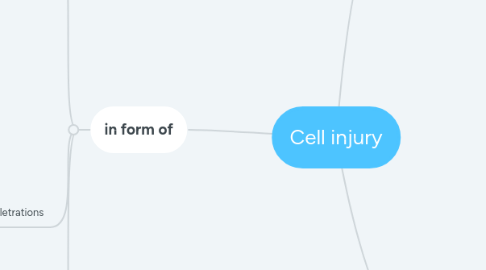
1. causes
1.1. Genetic
1.1.1. in born errors of metabolism, DNA damage
1.2. Acquired
1.2.1. Hypoxia and ischemia
1.2.2. Infectious agents
1.2.3. Physical agents
1.2.4. Chemical agents
1.2.5. Immunological agents
1.2.6. Nutritional imbalance
2. in form of
2.1. Apoptosis
2.1.1. Physiological
2.1.1.1. During embryogenesiss
2.1.1.2. During lactation
2.1.1.3. Involution of thymus gland
2.1.1.4. Uterus aftrer delivery
2.1.2. Pathological
2.1.2.1. Tumors exposed to chemotherapeutic agents.
2.1.2.2. Graft rejection reactions, by cytotoxic T cells
2.1.2.3. Viral hepatitis with formation of Councilman apoptotic bodies
2.1.2.4. Prostatic atrophy after orchiectomy due to hormonal deprivation.
2.1.2.5. In radiation and hypoxia.
2.1.2.6. Degenerative diseases of CNS like Alzheimer's disease
2.2. Subcellular aletrations
2.2.1. Intracellular accumulatouins
2.2.1.1. Normal constituents
2.2.1.1.1. Lipids : TAG, cholesterol and cholesteryl esters
2.2.1.1.2. Proteins
2.2.1.1.3. Carbohydrates
2.2.1.2. Abnormal metabolic Products
2.2.1.2.1. Due to abnormal metabolism or defective degradation (caused by lack of specific enzymes as inborn errors)
2.2.1.3. Pigment
2.2.1.3.1. Endogenous (excess)
2.2.1.3.2. Exogenous (inability to degrade them)
2.3. Reversible cell injusry
2.3.1. Necrosis
2.3.1.1. Coagulative necrosis
2.3.1.2. Liquefactive necrosis
2.3.1.3. Caseous necrosis
2.3.1.4. Fat necrosis
2.3.1.5. Fibrinoid necrosis
2.3.2. Necrosis + putrefaction (Gangrene)
2.3.2.1. Dry gangrene (senile gangrene)
2.3.2.2. Wet gangrene (moist gangrene)
